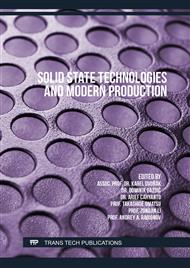[1]
Mohammadi-Bassir M, Babasafari M, Rezvani MB, Jamshidian M. Effect of coarse grinding, overglazing, and 2 polishing systems on the flexural strength, surface roughness, and phase transformation of yttrium-stabilized tetragonal zirconia. J Prosthet Dent 118 (2017) 658–65.
DOI: 10.1016/j.prosdent.2016.12.019
Google Scholar
[2]
Annusavice J. Phillip's science of dental. 12th ed. Philadephia: Elsevier; (2013).
Google Scholar
[3]
Chang IS, Lee S-H, Yang J-H, Han J-S, Lee J-B. The effect of surface finishes on flexural strength, fracture toughness of feldspathic dental Porcelain. J Korean Acad Prosthodont 43 (2005) 293–305.
Google Scholar
[4]
McCabe JF, Walls AWG. Applied Dental Materials. 9th ed. Blackwell, editor. London; (2008).
Google Scholar
[5]
Sakaguchi RL, JM P. Craig's restorative dental materials. 13th ed. Vol. 213. Elsevier; (2012).
Google Scholar
[6]
Preis V, Schmalzbauer M, Bougeard D, Schneider-Feyrer S, Rosentritt M. Surface properties of monolithic zirconia after dental adjustment treatments and in vitro wear simulation. J Dent (2015) 133–9.
DOI: 10.1016/j.jdent.2014.08.011
Google Scholar
[7]
Luthardt RG, Holzhüter M, Sandkuhl O, Herold V, Schnapp JD, Kuhlisch E, et al. Reliability and properties of ground Y-TZP-zirconia ceramics. J Dent Res 81 (2002) 487–91.
DOI: 10.1177/154405910208100711
Google Scholar
[8]
Etman MK, Woolford M, Dunne S. Quantitative measurement of tooth and ceramic wear: in vivo study. Int J Prosthodont 21 (2008) 245–52.
Google Scholar
[9]
Stawarczyk B, Özcan M, Schmutz F, Trottmann A, Roos M, Hämmerle CHF. Two-body wear of monolithic, veneered, and glazed zirconia and their corresponding enamel antagonists. Acta Odontol Scand 71 (2013) 102–12.
DOI: 10.3109/00016357.2011.654248
Google Scholar
[10]
Janyavula S, Lawson N, Cakir D, Beck P, Ramp LC, Burgess JO. The wear of polished and glazed zirconia against enamel. J Prosthet Dent 109 (2013) 22–9.
DOI: 10.1016/j.prosdent.2016.04.026
Google Scholar
[11]
Candido LM, Fais LMG, Reis JM dos SN, Pinelli LAP. Surface roughness and hardness of yttria-stabilized zirconia (Y-TZP) after 10 years of simulated brushing. Rev Odontol da UNESP 43 (2014) 379–83.
DOI: 10.1590/1807-2577.1049
Google Scholar
[12]
Bollen CM, Lambrechts P, Quirynen M. Comparison of surface roughness of oral hard materials to the threshold surface roughness for bacterial plaque retention: a review of the literature. Dent Mater 13 (1997) 258–69.
DOI: 10.1016/s0109-5641(97)80038-3
Google Scholar
[13]
Juntavee N, Attashu S. Effect of different sintering processes on flexural strength of translucency monolithic zirconia. J Clin Exp Dent 10 (2018) 821–30.
DOI: 10.4317/jced.54749
Google Scholar
[14]
Wright MD, Masri R, Driscoll CF, Romberg E, Thompson GA, Runyan DA. Comparison of three systems for the polishing of an ultra-low fusing dental porcelain. J Prosthet Dent 92 (2004) 3–5.
DOI: 10.1016/j.prosdent.2004.07.021
Google Scholar
[15]
Aravind P, Razak PA, Francis PG, Issac JK, Shanoj RP, Sasikumar TP. Comparative evaluation of the efficiency of four ceramic finishing systems. J Inter Oral Health 5 (2013) 59–64.
Google Scholar
[16]
Kumchai H, Juntavee P, Sun AF, Nathanson D. Effect of glazing on flexural strength of full-contour zirconia. Int J Dent 2 (2018) 1-5.
DOI: 10.1155/2018/8793481
Google Scholar
[17]
Bona A Della, Anusavice KJ, DeHoff PH. Weibull analysis and flexural strength of the hot-pressed core and veneered ceramic structures. Dent Mater 19 (2003) 662–9.
DOI: 10.1016/s0109-5641(03)00010-1
Google Scholar
[18]
Yener ES, Ozcan M, Kazazoǧlu E. The effect of glazing on the biaxial flexural strength of different zirconia core materials. Acta Odontol Latinoam 24 (2011) 133–40.
Google Scholar
[19]
Manawi M, Ozcan M, Madina M, Cura C, Valandro LF. Impact of surface finishes on the flexural strength and fracture toughness of In-Ceram Zirconia. Gen Dent 60 (2012) 138–42.
Google Scholar
[20]
International Organization for Standardization. ISO No.6872. Dentistry-Ceramic materials. Switzerland. (2015).
Google Scholar
[21]
Awalia W A, Sumarsongko T, Rikmasari R, Harmaji A, Cahyanto A. The flexural strength of Y-TZP coated with carbonate apatite for dental implant material. Key Eng Mater 829 (2019) 131–7.
DOI: 10.4028/www.scientific.net/kem.829.131
Google Scholar
[22]
Kosmač T, Oblak Č, Marion L. The effects of dental grinding and sandblasting on aging and fatigue behavior of dental zirconia (Y-TZP) ceramics. J Eur Ceram Soc 28 (2008) 1085–90.
DOI: 10.1016/j.jeurceramsoc.2007.09.013
Google Scholar
[23]
Hjerppe J, Fröberg K, Lassila LVJ, Vallittu PK. The effect of heat treatment and feldspathic glazing on some mechanical properties of zirconia. Silicon2 (2010) 171–8.
DOI: 10.1007/s12633-010-9042-y
Google Scholar
[24]
Her SB, Kim KH, Park SE, Park EJ. The effect of zirconia surface architecturing technique on the zirconia/veneer interfacial bond strength. J Adv Prosthodont 10 (2018) 259–64.
DOI: 10.4047/jap.2018.10.4.259
Google Scholar
[25]
Guazzato M, Quach L, Albakry M, Swain M V. Influence of surface and heat treatments on the flexural strength of Y-TZP dental ceramic. J Dent 33 (2005) 9–18.
DOI: 10.1016/j.jdent.2004.07.001
Google Scholar
[26]
Gupta S, Awinashe V, Palekar U, Gupta AS. Effects of surface abrasion on the flexural strength of glazed and re-glazed metal ceramics: An in vitro study. J Indian Prosthodont Soc 14 (2014) 110–4.
DOI: 10.1007/s13191-013-0293-3
Google Scholar
[27]
Hjerppe J, Närhi TO, Vallittu PK, Lassila LVJ. Surface roughness and the flexural and bend strength of zirconia after different surface treatments. J Prosthet Dent 116 (2016) 577–83.
DOI: 10.1016/j.prosdent.2016.02.018
Google Scholar
[28]
Alves LMM, Contreras LPC, Bueno MG, Campos TMB, Bresciani E, Valera MC, et al. The wear performance of glazed and polished full-contour zirconia. Braz Dent J 30 (2019) 51-8.
DOI: 10.1590/0103-6440201902801
Google Scholar
[29]
Subaşi MG, Demir N, Kara Ö, Nilgun Ozturk A, Özel F. Mechanical properties of zirconia after different surface treatments and repeated firings. J Adv Prosthodont 6 (2014) 462–7.
DOI: 10.4047/jap.2014.6.6.462
Google Scholar
[30]
Sandhu R, Kheur M, Kheur S. Effect of simulated chairside grinding procedures using commercially available abrasive agents on the surface properties of zirconia. J Indian Prosthodont Soc 22 (2017) 22–8.
DOI: 10.4103/0972-4052.194938
Google Scholar
[31]
Ramos GF, Pereira GKR, Amaral M, Valandro LF, Bottino MA. Effect of grinding and heat treatment on the mechanical behavior of zirconia ceramic. Braz Oral Res 30 (2016) 1–8.
DOI: 10.1590/1807-3107bor-2016.vol30.0012
Google Scholar
[32]
Traini T, Gherlone E, Parabita SF, Caputi S, Piattelli A. Fracture toughness and hardness of a Y-TZP dental ceramic after mechanical surface treatments. Clin Oral Investig 18 (2014) 707–14.
DOI: 10.1007/s00784-013-1018-z
Google Scholar



